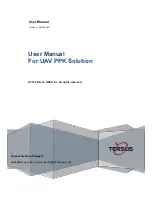
Appendix C: Calibrating the 888/24 I/O (Pro Tools 4.x)
19
appendix c
Calibrating the 888/24 I/O (Pro Tools 4.x)
Before you use the 888/24/I/O Audio Inter-
face, you may want to calibrate its input
and output levels to the level of your mix-
ing console.
The 888/24 I/O is factory-calibrated so that
its input operating level is set to +4 dB
nominal with 18 dB headroom nominal at
full code, unity gain, making calibration
unnecessary for most professional applica-
tions.
If you do need to recalibrate your interface
or other components of your studio, you
can use the alignment procedure described
here.
About Calibration
Calibrating levels on a digital recording de-
vice is different from calibrating levels on
an analog recording device. Unlike analog
devices, most digital devices do not have a
standard “0 VU” level setting that corre-
sponds to nominal input and output levels.
Instead, with an interface such as the
888/24 I/O, the meters are calibrated in
decibels below peak (digital clipping) level.
Headroom
The concept of headroom is slightly differ-
ent for analog and digital devices.
Analog
Most analog devices allow for a cer-
tain amount of headroom above 0 VU. If
you send a signal above the 0 VU level to
an analog recorder, you still have a margin
of headroom, and if tape saturation occurs,
it does so fairly gracefully, giving the audio
a compressed sound that some find desir-
able.
Digital
Digital devices, on the other hand,
do not allow for signals that exceed the dy-
namic range of the input. When a signal
exceeds the maximum input level for a dig-
ital device, clipping occurs, causing digital
distortion, which is harsh and usually un-
desirable.
The 888/24 I/O provides an industry stan-
dard headroom of 18 dB. The exact value
you use will be determined by the amount
of headroom available in the rest of your
system. For example, if your mixing con-
sole has 15 dB of headroom above nominal
level, then you may want to calibrate the
888/24 I/O to have 15 dB of headroom.




































